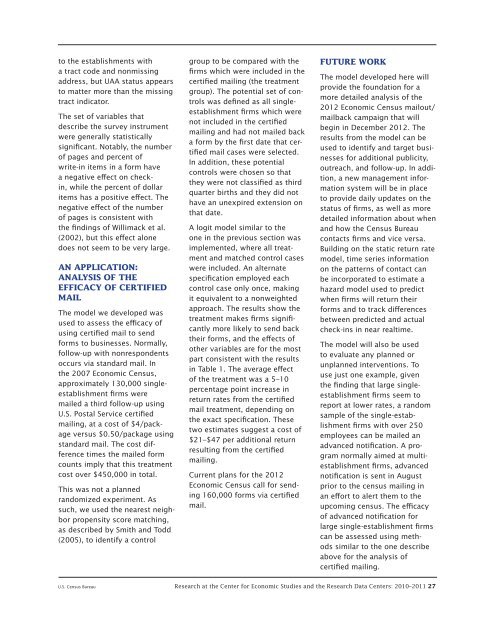2010 and 2011 - Census Bureau
2010 and 2011 - Census Bureau
2010 and 2011 - Census Bureau
Create successful ePaper yourself
Turn your PDF publications into a flip-book with our unique Google optimized e-Paper software.
to the establishments with<br />
a tract code <strong>and</strong> nonmissing<br />
address, but UAA status appears<br />
to matter more than the missing<br />
tract indicator.<br />
The set of variables that<br />
describe the survey instrument<br />
were generally statistically<br />
significant. Notably, the number<br />
of pages <strong>and</strong> percent of<br />
write-in items in a form have<br />
a negative effect on checkin,<br />
while the percent of dollar<br />
items has a positive effect. The<br />
negative effect of the number<br />
of pages is consistent with<br />
the findings of Willimack et al.<br />
(2002), but this effect alone<br />
does not seem to be very large.<br />
An ApplicAtion:<br />
AnAlysis oF tHe<br />
eFFicAcy oF certiFied<br />
MAil<br />
The model we developed was<br />
used to assess the efficacy of<br />
using certified mail to send<br />
forms to businesses. Normally,<br />
follow-up with nonrespondents<br />
occurs via st<strong>and</strong>ard mail. In<br />
the 2007 Economic <strong>Census</strong>,<br />
approximately 130,000 singleestablishment<br />
firms were<br />
mailed a third follow-up using<br />
U.S. Postal Service certified<br />
mailing, at a cost of $4/package<br />
versus $0.50/package using<br />
st<strong>and</strong>ard mail. The cost difference<br />
times the mailed form<br />
counts imply that this treatment<br />
cost over $450,000 in total.<br />
This was not a planned<br />
r<strong>and</strong>omized experiment. As<br />
such, we used the nearest neighbor<br />
propensity score matching,<br />
as described by Smith <strong>and</strong> Todd<br />
(2005), to identify a control<br />
group to be compared with the<br />
firms which were included in the<br />
certified mailing (the treatment<br />
group). The potential set of controls<br />
was defined as all singleestablishment<br />
firms which were<br />
not included in the certified<br />
mailing <strong>and</strong> had not mailed back<br />
a form by the first date that certified<br />
mail cases were selected.<br />
In addition, these potential<br />
controls were chosen so that<br />
they were not classified as third<br />
quarter births <strong>and</strong> they did not<br />
have an unexpired extension on<br />
that date.<br />
A logit model similar to the<br />
one in the previous section was<br />
implemented, where all treatment<br />
<strong>and</strong> matched control cases<br />
were included. An alternate<br />
specification employed each<br />
control case only once, making<br />
it equivalent to a nonweighted<br />
approach. The results show the<br />
treatment makes firms significantly<br />
more likely to send back<br />
their forms, <strong>and</strong> the effects of<br />
other variables are for the most<br />
part consistent with the results<br />
in Table 1. The average effect<br />
of the treatment was a 5–10<br />
percentage point increase in<br />
return rates from the certified<br />
mail treatment, depending on<br />
the exact specification. These<br />
two estimates suggest a cost of<br />
$21–$47 per additional return<br />
resulting from the certified<br />
mailing.<br />
Current plans for the 2012<br />
Economic <strong>Census</strong> call for sending<br />
160,000 forms via certified<br />
mail.<br />
Future work<br />
The model developed here will<br />
provide the foundation for a<br />
more detailed analysis of the<br />
2012 Economic <strong>Census</strong> mailout/<br />
mailback campaign that will<br />
begin in December 2012. The<br />
results from the model can be<br />
used to identify <strong>and</strong> target businesses<br />
for additional publicity,<br />
outreach, <strong>and</strong> follow-up. In addition,<br />
a new management information<br />
system will be in place<br />
to provide daily updates on the<br />
status of firms, as well as more<br />
detailed information about when<br />
<strong>and</strong> how the <strong>Census</strong> <strong>Bureau</strong><br />
contacts firms <strong>and</strong> vice versa.<br />
Building on the static return rate<br />
model, time series information<br />
on the patterns of contact can<br />
be incorporated to estimate a<br />
hazard model used to predict<br />
when firms will return their<br />
forms <strong>and</strong> to track differences<br />
between predicted <strong>and</strong> actual<br />
check-ins in near realtime.<br />
The model will also be used<br />
to evaluate any planned or<br />
unplanned interventions. To<br />
use just one example, given<br />
the finding that large single-<br />
establishment firms seem to<br />
report at lower rates, a r<strong>and</strong>om<br />
sample of the single-establishment<br />
firms with over 250<br />
employees can be mailed an<br />
advanced notification. A program<br />
normally aimed at multiestablishment<br />
firms, advanced<br />
notification is sent in August<br />
prior to the census mailing in<br />
an effort to alert them to the<br />
upcoming census. The efficacy<br />
of advanced notification for<br />
large single-establishment firms<br />
can be assessed using methods<br />
similar to the one describe<br />
above for the analysis of<br />
certified mailing.<br />
U.S. <strong>Census</strong> <strong>Bureau</strong> Research at the Center for Economic Studies <strong>and</strong> the Research Data Centers: <strong>2010</strong>–<strong>2011</strong> 27

















